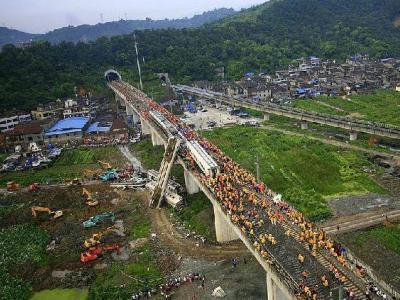
CHINA: Investigators have confirmed that 'serious design flaws' in the signalling and train control equipment, along with 'sloppy management and the mishandling of a lightning strike' were among the reasons for the collision between two high speed trains near Wenzhou on July 23 2011 in which 40 people died.
Originally expected in September, the official report was issued via the website of China's State Administration of Work Safety on December 28. An executive meeting of the State Council was informed that 54 people shared the blame for the accident, including former railway minister, Liu Zhijun, who was dismissed last year over corruption charges.
Although lacking some technical details, the report confirms the root causes of the crash, including recorded conversations between the train drivers and the line dispatcher.
According to the official report, station technician Zang Kai noticed three malfunctioning signals near Wenzhou, but failed to spot a fourth. This was transmitting a false green aspect following the failure of a fuse in an LKD2-T1 signal assembly, which appears to have knocked out the track circuit detection.
Dispatcher Zhang Hua was dealing with at least 10 trains during a storm with up to 50 lightning strikes per minute. Having been notified about the defective signals, he authorised train D3115 to proceed with caution, telling the driver He Li 'if you come across red lights, switch to visual running procedures, and maintain speed below 20 km/h'.
D3115 was brought to a stand by the defective signalling, and He Li tried to over-ride the ATP in order to continue. But he could not contact the dispatcher by radio, and the train was not being detected by the faulty track circuit. With the control centre display showing a false clear, Zhang authorised the train D301 to proceed.
After standing more than 7 min, He managed to get D3115 moving again, entering the next track circuit which caused the train to reappear on the control centre display. Although the dispatchers realised the danger and attempted to contact D301's driver Pan Yiheng by radio, the collision occurred less than a minute later.
The official report discusses whether the rapid construction of the high speed network may have contributed to faults in the safety systems, but does not say whether similar problems have been found elsewhere.

















